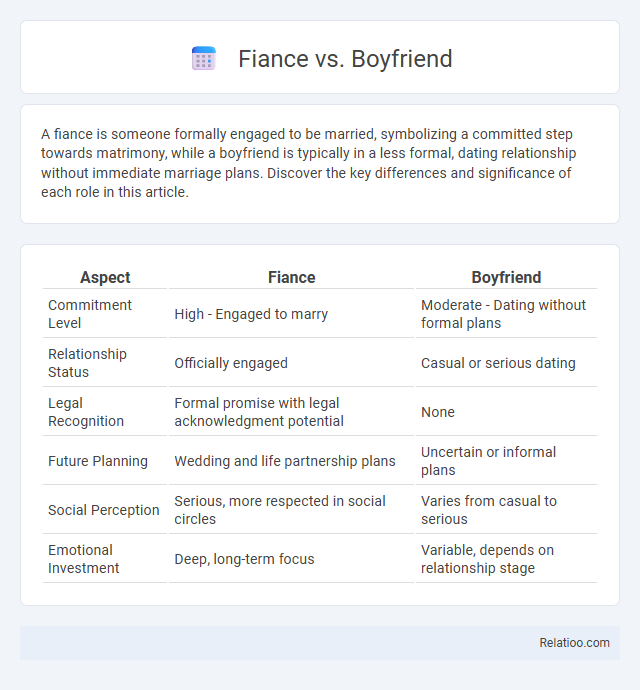A fiance is someone formally engaged to be married, symbolizing a committed step towards matrimony, while a boyfriend is typically in a less formal, dating relationship without immediate marriage plans. Discover the key differences and significance of each role in this article.
Table of Comparison
| Aspect | Fiance | Boyfriend |
|---|---|---|
| Commitment Level | High - Engaged to marry | Moderate - Dating without formal plans |
| Relationship Status | Officially engaged | Casual or serious dating |
| Legal Recognition | Formal promise with legal acknowledgment potential | None |
| Future Planning | Wedding and life partnership plans | Uncertain or informal plans |
| Social Perception | Serious, more respected in social circles | Varies from casual to serious |
| Emotional Investment | Deep, long-term focus | Variable, depends on relationship stage |
Understanding the Terms: Fiancé vs Boyfriend
Understanding the terms fiance and boyfriend involves recognizing differing levels of commitment and societal expectations; a fiance is someone engaged to be married, representing a formal promise to wed and often involves planning a future together. The boyfriend role typically implies a romantic relationship without the legal or social obligation tied to marriage. Role expectations for a fiance often include preparations for marriage, shared decision-making about long-term goals, and increased family involvement, whereas boyfriend expectations may remain more flexible and centered on emotional connection and companionship.
Key Differences in Commitment Levels
Fiance status signifies a formal commitment to marriage, often involving engagement rings, wedding planning, and public acknowledgment, whereas a boyfriend relationship typically lacks explicit future intentions and legal implications. Role expectations for fiances include preparing for shared financial responsibilities and aligning life goals, while boyfriends often maintain more flexibility and independence. The commitment level in a fiance relationship is legally and socially recognized as a precursor to marriage, contrasting with the more casual and undefined nature of boyfriend roles.
Social Perceptions and Expectations
Social perceptions of a fiance often emphasize commitment, future planning, and societal approval more than those of a boyfriend, who is typically viewed as less formally committed and more exploratory. Role expectations for a fiance include preparing for marriage, aligning family values, and demonstrating long-term reliability, whereas boyfriends face looser expectations focused on dating and emotional connection without immediate obligations. These differences shape how individuals and communities interpret relationship status, influencing behaviors, social support, and the perceived seriousness between partners.
Legal Implications of the Relationships
Fiance status carries specific legal implications, such as eligibility for marriage-related benefits, rights, and potential spousal support upon engagement dissolution, which usually do not apply to boyfriends. Your legal obligations and protections increase significantly once engaged, including considerations for joint financial planning and healthcare decisions. Understanding these distinctions ensures clarity in expectations and responsibilities within evolving relationship roles.
Emotional Dynamics in Engagement vs Dating
Emotional dynamics in engagement differ significantly from those in dating, as your relationship with a fiance involves deeper commitment and shared future planning, intensifying feelings of security and responsibility. Unlike the exploratory nature of dating a boyfriend, engagement typically brings heightened emotional intimacy, trust, and a clearer understanding of mutual expectations. Role expectations evolve with engagement, requiring emotional maturity and support that surpass the more flexible, often experimental emotional patterns found in dating relationships.
Cultural Significance and Traditions
Fiance, boyfriend, and role expectations differ significantly across cultures, reflecting societal norms and traditional values. In many cultures, a fiance holds a formal status involving family approval, engagement rituals, and clear marital intentions, whereas a boyfriend denotes a less formal romantic relationship without immediate commitments. Cultural significance often dictates specific ceremonies, gifts, and public acknowledgment for fiances, emphasizing the transition towards marriage and aligning with longstanding traditions.
Role of Family and Friends
Fiance, boyfriend, and their role expectations differ significantly, especially regarding family and friends' involvement; a fiance is often seen as a future spouse with formal approval and integration into both families, while a boyfriend may have a more casual or exploratory status without deep familial commitments. Families and friends play crucial roles in shaping these expectations by offering support, advice, and sometimes pressure, which can influence relationship dynamics and progression. Clear communication about roles and boundaries helps manage expectations and fosters stronger bonds among partners, their families, and social circles.
Planning for the Future: Engagement vs Relationship
Fiance status typically involves explicit planning for a shared future, including marriage, joint finances, and long-term life goals, while a boyfriend relationship may lack this formal commitment and concrete plan. Role expectations for a fiance include active collaboration on wedding preparations, setting timelines, and discussing potential family planning, housing, and career decisions. In contrast, boyfriend relationships often focus on exploring compatibility and emotional connection without immediate pressure for life-altering commitments.
Milestones: From Boyfriend to Fiancé
The transition from boyfriend to fiance marks a significant milestone characterized by increased commitment and mutual agreement to marry, often following key relationship developments such as meeting families, discussing future goals, and establishing long-term trust. Role expectations evolve considerably, with the fiance role encompassing plans for shared life responsibilities, financial discussions, and deeper emotional support compared to the boyfriend stage. This progression reflects a shift from dating dynamics to partnership preparation, emphasizing engagement as a formal step toward marriage readiness.
Making the Transition: What to Consider
Making the transition from boyfriend to fiance involves clear communication about mutual expectations, commitment levels, and future plans. Understanding the evolving role expectations includes discussing financial responsibilities, living arrangements, and long-term goals to ensure alignment. Prioritizing emotional readiness and shared values facilitates a smoother progression towards engagement and eventual marriage.

Infographic: Fiancé vs Boyfriend
 relatioo.com
relatioo.com